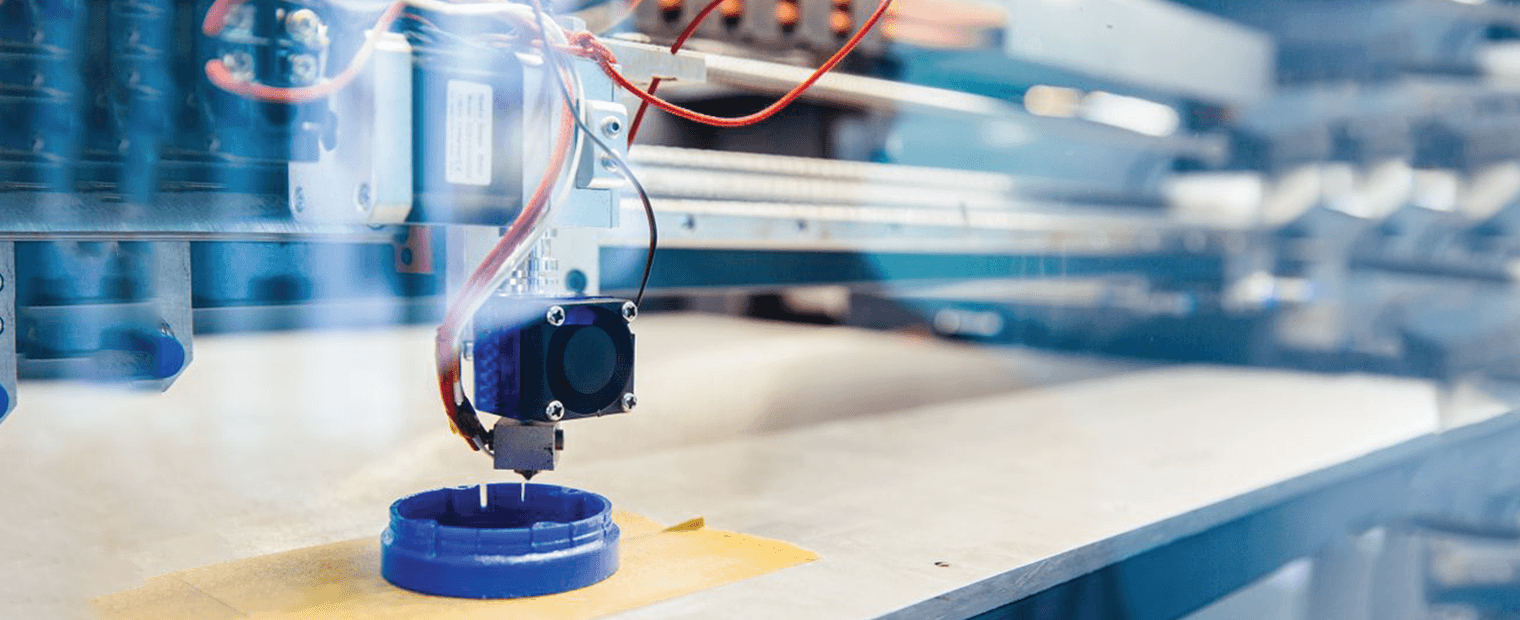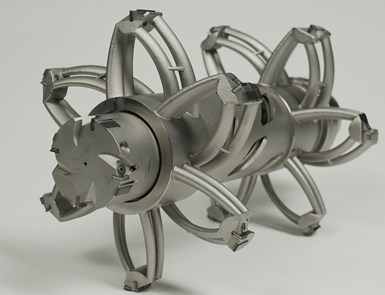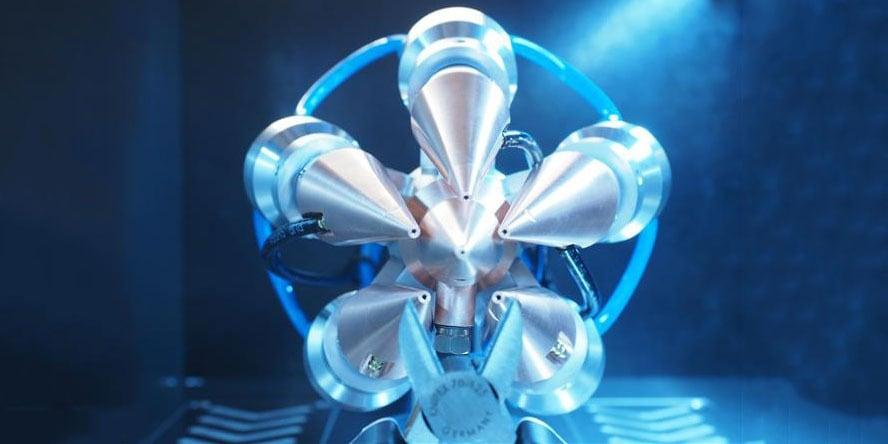Abstract : Due to the different gradient of large size metal parts printing, with the increase of the number and the height of the printing layer, the structure of the longitudinal gradient is not uniform, and the tensile strength at different positions of the gradient will be clearly unstable. In order to solve these problems, the application research of integrated 3D printing technology in metal parts processing is proposed. The dynamic adaptive power reduction processing circuit is used to reduce the heat accumulation effect in the 3D printing process, so that the printed metal parts are more uniform and the performance is further improved. And it was simulated and verified.
Keywords : metal ; parts ; 3D printing
3D printing technology is based on the basic principle of rapid spray molding production. It is formed by adding a metal powder, combined with a high density and high energy laser beam as a heating source, using a 3D digital CAD model as 3D. Size molding the frame, and the motion trajectory is preformed according to the procedure. Metal parts with complex structures and excellent properties. In the process of microscopic characterization of multi-layer printing metal parts, it was found that the longitudinal gradient gradually increased with the number of layers, the column crystal coarsening obviously, the tissue was seriously uneven along the longitudinal gradient direction, and the number of defects such as stomata, holes, and inclusions also increased greatly. For lower, central and upper different space position such as proportional tensile test, found the longitudinal gradient strength and plasticity, in order to solve these problems, obtain the overall organization and performance of laser 3D printing metal parts, this paper puts forward the fusion of metal parts processing called 3D printing technology application research. According to the processing scheme of dynamic adaptive power reduction, the thermal accumulation effect in the 3D printing process is reduced, making the printed metal parts more uniform, and further improving the performance of the metal parts. The simulation model of dynamic 3 D transient temperature field is established and verified.
.jpeg)
1 Integration of 3D printing equipment and operation process in metal parts processing
The experiment uses a 3D printing equipment system, which emits a laser wavelength of 1060 nm, and the laser conduction of the external optical path is a 1000 nm fiber. It is then connected to the laser 3D printing head, and the metal powder is fed through the powder feeder. The three-axis CNC machine tool controlled by Siemens CNC system is used as the working platform. It is equipped with an inert gas protection glove box, constant temperature circulating water cooling, copper substrate and Ar air flow system.
( 1 ) Before the test in the powder feeder, local Incone1625 metal powder, powder feeder to adjust the speed, so that the powder feed rate of 18 g / min. The ultimate goal - to provide a uniform distribution of the alloy powder, without interference with the light output of the laser beam and to ensure that the current powder and the laser beam convergence effect.
( 2 ) The dried 20G substrate was transferred through the transfer chamber, placed on a worktable with a constant temperature copper substrate, placed in an inert gas-protected glove box, and then the thermally conductive adhesive was evenly applied to the contact surface of the 20G substrate and water-cooled copper plate. The ultimate goal is to maintain a good forming effect in the 3D laser printing process.
( 3 ) The distance between the laser head and the 20G substrate is adjusted to 15mm, so that the laser beam and the powder flow from the coaxial four-way hydrogen powder supply line have a good convergence effect.
( 4 ) Finally, the pre-designed CNCNumericG code is loaded into the CNC system, and the printing path will be parallel and in the same direction. Then you can adjust the test parameters that need to be changed on the control panel, including laser output power, scanning speed, etc., check whether the indicators work, and run the test after meeting the standards. ( 5 ) After the test is completed, the sample is cooled, the printed sample is taken out in digital order, and then the systematic inspection and analysis are carried out.

2 Modeling of transient temperature field of 3D printing in metal parts processing
The Fusion3D printing process of metal parts is a complex process. These microscopic mechanisms interact with each other and cannot be accurately detected and analyzed by the naked eye in technical equipment. In the processing of metal parts, only relying on the test method to analyze the interaction between different factors, a large number of tests are needed to obtain the best process and parameters of thin-walled processing, which inevitably leads to the loss of manpower and material resources. A simple test process cannot quantitatively reveal the evolution law and the mechanism of microstructure change. The modeling method allows the visualization, three-dimensional and dynamic display of the research object, such as the evolution of the unsteady temperature field.
According to the demand design of decreasing power experiment scheme, this scheme is an adaptive flexible analysis method, decreasing refers to the applied power value can start from 2200 W, 0W~30 W by single layer by layer or three OW ~ 30 W down to the required layers, make the gradient direction maximum low heat input and better performance and organize large size 30 layers of metal parts. This is a dynamic and variable process, the tissue uniformity and performance uniformity of the forming are improved. Model, printing, forming, can find 30 layer 20W sample printed in the same direction, length 80mm, 17mm, 3mm width, surface forming continuous and smooth, obvious metal luster, good perpendiculality, no macroscopic pores, inclusion, and crack defects, can be found between each layer and printing layer and matrix interface fusion good, and 30 layer 30W sample printed in the same direction, length.Degree 80mm, height 17mm, width 3mm ~1.5mm gradient, will find an obvious phenomenon of upper thin and lower thick, mainly because the heat input is significantly reduced and the surface roughness of the sample is lower than the former.

2.1 Microstructure of metal parts after process optimization
In the process of laser 3D printing metal parts, with the increase of the number of printing layers, the laser beam heat source continues to heat the printing layer and the substrate layer. At this time, the heat dissipation conditions will also be reduced, resulting in a sharp rise in the overall temperature of the printed part. At the same time, the forming process of each printing layer will have a heating effect on the first few layers of the layer, resulting in uneven grain size along the longitudinal gradient. The sample with 20 W heat input decreasing layer by layer is more uniform than the sample with 30 W heat input decreasing layer by layer, the grain distribution is more dispersed, and the relative size difference is smaller, which effectively shows that the idea of the new processing scheme is helpful to the formation of uniform structure of metal parts.
.png)
Fig.1 Process optimization of three-dimensional microstructure of INCONEL62s metal parts at different gradient positions
Fig.1 shows the three-dimensional morphology of different gradient positions of metal parts after laser 3D printing process optimization. From the diagram, it can be found that the microstructure of the wall parts of the two sets of processing schemes is uniform and dense. However, the height of the liquid phase may exceed the thickness of a printing layer. When the laser beam source is scanned onto the alloy powder, the laser power is appropriate and large enough, and the scanning speed is optimized after a unified dimension.
From the diagram, it is not difficult to see that most of the growth on the cross section is thin and long columnar crystals. After layer-by-layer printing, the growth direction of dendrite grains in the laser scanning structure during the process can also be known. The process of laser 3D printing metal parts, in which the important temperature gradient is vertical downward, is because the laser beam surface heat source is gradually scanning, and the temperature gradient value in the front of the heat source is greater than the temperature gradient value in the rear of the heat source. From the diagram, it can be seen that the microstructure difference in different regions of metal parts is obviously reduced. The lower structure of 20 W layer-by-layer decreasing and the upper columnar crystal structure size are basically quite strict epitaxial growth characteristics. Compared with the lower and upper values of the 30W layer-by-layer decreasing, the lower and upper columnar crystals of the 30W layer-by-layer sample also show more uniform characteristics.
After the EDS surface scan of the 20 W metal parts with more uniform structure of the above 3D printing metal parts, it was found that it was mainly composed of solid solution, and there was a certain number of Laves phases with irregular distribution between columnar crystals and dendrites. The microstructure of 20 W layer-by-layer decreasing samples was further analyzed by energy spectrum. From the EDS morphology distribution, it is found that there are two different precipitated phases in the specimen, one is the matrix solid solution,the other is that the number of precipitated phases with irregular shape and irregular distribution is large, which is dispersed in the whole wall. It can be seen that as the height of the sample increases, the heat continues to accumulate, the cooling rate continues to decrease, and the distance between the dendrites of the columnar crystals is gradually expanding. In the middle and upper parts of the sample, the secondary dendrites between adjacent dendrites intersect with each other to reduce the precipitated phase.

2.2 Performance of metal parts after process optimization
In this paper, the process of 3D printing metal parts from single channel to thin-walled forming is studied, and the optimal process parameters of single channel printing are analyzed. The optimal process parameters are used to print large-size forming parts. The morphology and performance of dendrites at different heights show inhomogeneity and inconsistency. Aiming at this problem, a scheme for regulating heat input is proposed.
The processing technology of 3D printing of metal parts is carried out by printing 10 layers, 20 layers and 30 layers. The microstructure is mainly columnar dendrites, and the growth direction of dendrite grains is approximately perpendicular to the scanning direction of the laser beam.
The temperature field model of 3D printed metal parts was established, and the change process of three-dimensional transient temperature field during its formation process was simulated. The characteristic points were analyzed. It was found that the peak temperature of the center points of each analysis step after the fifth printing layer was basically the same and then began to decline. At the same time, the temperature thermal cycle profile is similar. From the thermal cycle curve calculated by the characteristic points of each analysis step of each printing layer, it can be seen that the 3D printing process is a process of rapid heating and cooling. The peak value of the center point of each analysis step of the post-printing layer is higher than that of the previous printing layer, but this increase will be smaller and smaller.
As the printing process progresses, the printed sample will produce heat accumulation. Therefore, the schemes of reducing heat input by 30 W and 20 W layer by layer were designed. The sample with 20 W heat input decreasing layer by layer is more uniform than the sample with 30 W decreasing layer by layer. After EDS surface scanning of 20 W decreasing metal parts, it was found that it was mainly solid solution, and there were a certain number of irregularly distributed Laves phases between columnar crystals and dendrites, which were dispersed in the whole metal parts. The 30-layer metal parts with 30 W decreasing layer by layer show more uniform tensile strength and plasticity in the height direction than the 30-layer samples with 20 W decreasing layer by layer and the 30-layer samples printed with the same power. The strength is about 700 MPa and the plastic elongation is about 60 %.
In summary, the metal parts manufactured by the fusion of 3D printing technology in the processing of metal parts are more uniform than the traditional methods, and the performance of metal parts has been further improved.
3 Conclusion
This paper mainly focuses on the research of fusion 3D printing technology in metal parts processing. The influence of different process parameters on the uniformity of microstructure and properties of 3D formed metal parts is discussed by simulation analysis. Although the method of reducing heat input layer by layer can improve the microstructure uniformity and performance uniformity of large-size metal parts with a parameter to the end to a certain extent, the process parameters such as the flow rate of protective gas and the degree of convergence of powder particles in the forming process are quantitatively and accurately matched. The process needs further analysis and research to make the scheme more refined. Although some progress has been made, there are still many more detailed problems that need further systematic research and solution.
FAQ 1: How does 3D printing technology benefit metal parts processing?
Answer: 3D printing technology offers several advantages in metal parts processing:
- Complex Geometries: 3D printing allows the creation of intricate and complex metal parts that are challenging or impossible to manufacture using traditional methods.
- Design Flexibility: With 3D printing, engineers can optimize designs for specific applications, reducing material usage and overall weight.
- Rapid Prototyping: 3D printing enables quick and cost-effective production of metal prototypes, accelerating the product development cycle.
- Customization: Manufacturers can easily produce small batches or one-off metal parts tailored to individual customer requirements.
FAQ 2: What are some promising applications of 3D printing in metal parts processing?
Answer: The fusion of 3D printing technology in metal parts processing has opened up new possibilities across various industries:
- Aerospace: 3D printing is utilized to fabricate lightweight and complex components, leading to fuel efficiency and reduced emissions.
- Medical: Additive manufacturing enables the production of patient-specific implants and medical instruments, improving patient outcomes.
- Automotive: 3D printed metal parts contribute to vehicle weight reduction, enhancing performance and energy efficiency.
- Industrial: Complex tooling and customized metal parts can be efficiently manufactured using 3D printing, optimizing production processes.
FAQ 3: What challenges does the integration of 3D printing pose in metal parts processing?
Answer: While 3D printing has transformative potential, it also comes with some challenges:
- Material Selection: Limited availability of suitable metal alloys and materials can restrict the range of applications and material properties.
- Quality Control: Ensuring consistent material quality and structural integrity across 3D printed metal parts requires robust quality control measures.
- Post-Processing: Some 3D printed metal parts may require additional post-processing steps, like heat treatment or finishing, to meet specific industry standards.
- Cost Considerations: Initial investment costs for 3D printing equipment and materials can be significant, especially for high-precision metal parts.
How to Contact Us:
- Visit our website: https://www.nbyichou.com/
- Email us: [email protected]
- Call us/whatsapp: +86 13355741031
- Chat with us: Live chat support available on our website